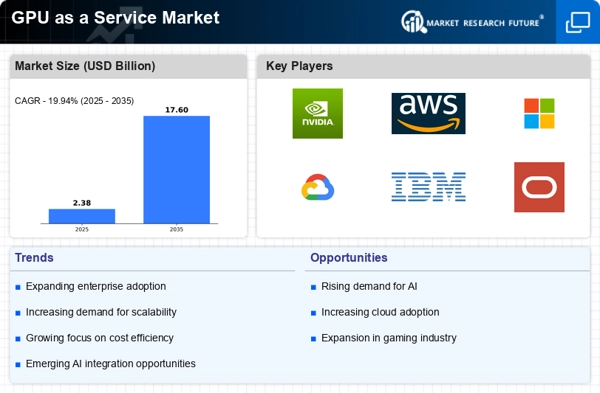Emergence of Edge Computing
The rise of edge computing is significantly influencing the GPU as a Service Market. As more devices become interconnected and generate vast amounts of data, the need for localized processing has become apparent. Edge computing allows for real-time data analysis and decision-making, which is crucial for applications such as autonomous vehicles, smart cities, and IoT devices. By integrating GPU capabilities at the edge, organizations can enhance their operational efficiency and reduce latency. This shift towards edge computing is expected to create new opportunities for GPU as a Service Market providers, as they can offer tailored solutions that meet the specific requirements of edge applications. The market for edge computing is projected to grow substantially, further driving the demand for GPU resources.
Rising Focus on Cost Efficiency
The rising focus on cost efficiency is a significant driver for the GPU as a Service Market. Organizations are continually seeking ways to optimize their IT expenditures while maintaining high performance levels. GPU as a Service Market solutions provide a compelling alternative to traditional on-premises GPU deployments, as they eliminate the need for substantial capital investments in hardware. By adopting a pay-as-you-go model, businesses can align their GPU usage with actual demand, thereby reducing waste and improving cost management. This trend is particularly relevant for startups and small to medium-sized enterprises that may lack the resources for large-scale infrastructure investments. As the emphasis on cost efficiency continues to grow, the GPU as a Service Market is likely to expand, attracting a broader range of customers.
Growth of Data-Intensive Applications
The proliferation of data-intensive applications is a key driver for the GPU as a Service Market. As organizations increasingly rely on big data analytics, machine learning, and artificial intelligence, the demand for robust GPU resources has intensified. It is estimated that the global data volume is expected to reach 175 zettabytes by 2025, necessitating advanced processing capabilities. GPU as a Service Market solutions offer the flexibility and scalability required to manage these vast datasets effectively. By utilizing these services, companies can optimize their data processing tasks, reduce time-to-insight, and enhance overall productivity. This trend indicates a strong market potential for GPU as a Service Market providers, as they cater to the evolving needs of data-driven enterprises.
Advancements in Virtualization Technologies
Advancements in virtualization technologies are playing a pivotal role in shaping the GPU as a Service Market. Virtualization allows multiple users to share GPU resources efficiently, maximizing utilization and reducing costs. This technology enables organizations to deploy GPU resources on-demand, facilitating a more agile and responsive IT environment. As businesses increasingly adopt hybrid and multi-cloud strategies, the need for effective virtualization solutions becomes paramount. The GPU as a Service Market is anticipated to witness a robust growth trajectory, which will likely bolster the GPU as a Service Market offerings. By leveraging these advancements, companies can enhance their operational flexibility and optimize resource allocation, ultimately driving growth in the GPU as a Service Market sector.
Increasing Adoption of High-Performance Computing
The GPU as a Service Market is experiencing a notable surge in the adoption of high-performance computing (HPC) solutions. Organizations are increasingly recognizing the need for advanced computational capabilities to handle complex workloads, particularly in sectors such as scientific research, financial modeling, and data analytics. According to recent estimates, the HPC market is projected to grow at a compound annual growth rate (CAGR) of approximately 7% over the next few years. This growth is likely to drive demand for GPU as a Service Market offerings, as they provide scalable and cost-effective access to powerful GPU resources without the need for substantial upfront investments in hardware. Consequently, businesses can leverage these services to enhance their computational efficiency and accelerate innovation.


















Leave a Comment